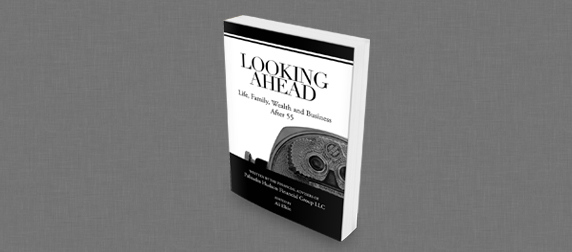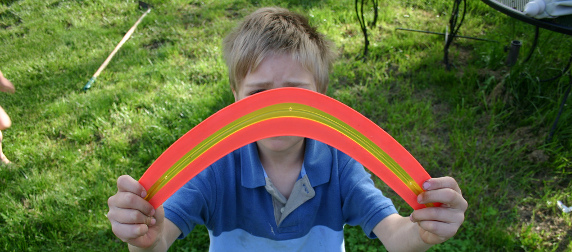
If life is like a book, a new chapter often starts when we are in our 50s and 60s - which is why my colleagues and I wrote a book that begins, metaphorically, with this chapter, squarely in the middle of middle age.
Today marks the official release of Looking Ahead: Life, Family, Wealth and Business After 55. You can find it in print at Amazon and Barnes & Noble, among other vendors. There is a Kindle version as well.
Looking Ahead is the combined work of all of the client service executives, managers and senior staff at Palisades Hudson Financial Group. We divided 19 chapter topics among ourselves, each signing our own chapters as authors. Besides the introduction, my topic was the family business – fitting, since I started and still own our firm, and also because my journalist daughter Ali Elkin edited Looking Ahead for us. Ali’s name, and Palisades Hudson’s, are the ones you will find on the cover.
Many of the book’s topics are relevant at almost any age; examples include education funding, planning for incapacity, and investment psychology and strategy. I suspect Looking Ahead is going to find an audience among younger adults who are not its primary target, and I also suspect that many will pass it along to their parents. A lot of those parents will be baby boomers like me.
People my age typically have kids who are grown and, we hope, independent or on their way to independence. Our careers are moving through their final stages, or we are just transitioning to retirement.
But our stories are far from over. Children and grandchildren may not live under our roofs, but we still play a significant role in their lives. We now have time and energy, and maybe some money, to devote to second careers, to hobbies, and to community and charitable endeavors. The assets we inherited from our families or accumulated ourselves require thoughtful stewardship, in part to protect them from exorbitant taxes. We also must consider how to arrange and pay for our own care once we can no longer look after ourselves.
To succeed in later life we first have to define success. In business, this is easy: The goal usually is maximum profit or the highest possible return on investment. However, life is about much more than business and success is not usually measured by the bottom line. I have been a personal financial adviser for nearly 30 years. I have yet to have a client tell me his or her goal is to die with the maximum possible net worth.
Setting goals, and setting priorities among conflicting goals, is one of the most important exercises in financial planning, yet it is often slighted. Think about how many people fail at investing because they start by chasing the highest returns with the riskiest investments, and then sell their holdings at the worst possible time. This happens because people do not set realistic goals or because they fail to evaluate their appetite for risk to achieve those goals.
Such mistakes regularly occur in many areas of financial life beyond investing. Businesses fail for lack of thoughtful succession plans. Insurance dollars are wasted on the wrong products. Opportunities to save on taxes are overlooked. Children and grandchildren are burdened with education debt, or are not given the right incentives to help them use family wealth to help them make the most of their lives.
Far too much of what is called “financial planning” is conducted as though the adviser and the client are wearing blinders. Accountants talk about income taxes. Lawyers want to write wills and trusts. Insurance agents sell the solution to every problem. Often, the term “financial planning” is used almost synonymously with investing, which makes no sense. We should save and invest to achieve goals that matter to us, not just because we want to outperform our friends.
Our firm’s philosophy, which focuses first on the big picture and only then on the details, governs our daily work and led us to write Looking Ahead the way we did. We included chapters on “hard” topics like federal and state income taxes and estate planning, but we also wrote about so-called “soft” subjects like the relationship of family wealth with children and grandchildren, and about personal priorities like philanthropy, retiring abroad or starting a business after retiring from a former career.
It has been 20 years since I last wrote a book. As you can imagine, the process was different this time. Even my earlier topic - financial planning for unmarried couples, back in the days before same-sex marriage was a fast-rising reality - is scarcely relevant to the world in which we live today.
Back then, a publisher paid me an advance, half when I signed my contract and half when I delivered the manuscript. The publisher then had in-house editors to work with me, a graphic designer to create the layout and cover, and a publicity department to send me on a national media tour (though the bookings were scant until I had my own office staff commandeer the process).
This time there was no advance, because our firm published the book using Amazon’s CreateSpace platform. Besides my daughter Ali, we had ample talent in-house to create the book ourselves. Communications manager Amy Laburda helped with much of the drafting, and our graphic artist Ashley Dandridge created a handsome book design. Ashley handled all the interactions with CreateSpace and with Amazon’s Kindle unit, which created the e-book from our manuscript. Most authors do not have all this editorial talent in house, of course; CreateSpace offers additional support services for them. Thanks to these resources, self-publishing is growing at a remarkable rate, although of course the products are of uneven quality and many of them will never find much of an audience.
We have bigger goals for Looking Ahead. Though it will probably never make any best-seller lists, I think we created a book in which we can take pride, and through which we can reach a broader readership than we could ever hope to help in person. And although I may be biased, I think Looking Ahead is a fine showcase for the varied talents of the people who wrote and created it. I want our firm’s clients and friends to see it, and I want their families to have it as a keepsake.
As for me? Well, in the hope that most of my co-workers do not read this far into my columns, I will let you in on a secret. I am looking ahead to another book. Not right away, but not 20 years from now, either.













December 15, 2014 - 8:44 pm
The book has excellent guidance, and is very informative. This is unique, distinguished and very superb!